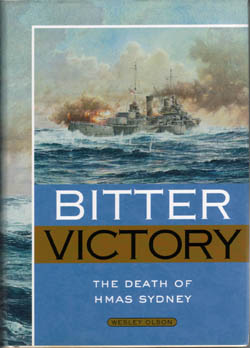 Before
you go "Oh no, not another book on the loss of the HMAS Sydney", read
through this review and then go buy the book, it'll be worth your while - but
I'm getting ahead of myself here.
Before
you go "Oh no, not another book on the loss of the HMAS Sydney", read
through this review and then go buy the book, it'll be worth your while - but
I'm getting ahead of myself here.Bitter Victory
The Death of HMAS Sydney
Author: Wesley Olsen
By: Shane Jenkins
 Before
you go "Oh no, not another book on the loss of the HMAS Sydney", read
through this review and then go buy the book, it'll be worth your while - but
I'm getting ahead of myself here.
Before
you go "Oh no, not another book on the loss of the HMAS Sydney", read
through this review and then go buy the book, it'll be worth your while - but
I'm getting ahead of myself here.
The author has been researching the loss of the Sydney since 1992, and led
to publishing two reports for the Western Australia Maritime Museum, before
publishing this book in 2000.
Starting with a brief history and detailed description of HMAS Sydney, complete
with a foldout GA drawing, we are given a complete overview of how HMAS Sydney
worked. This also includes a section on proposed A & As (Alterations &
Additions) and wartime modifications.
The book then turns to the non arrival of HMAS Sydney on the 20th November, 1941. After radioing Sydney to break radio silence on Sunday the 23rd, the book goes on describe the search efforts which started on the 24th and the Kormoran's survivors being picked up. The search was called off on the 29th, by which time it was realised that Sydney had been lost with all hands, whilst there were survivors from the Kormoran. We are led thru the events of interrogation of Kormoran's survivors and the piecing together of what happened as well as the political process of releasing details to the public and how pressure was applied to get the news out.
Taking a step back, the author then describes what he terms "the tonnage war". This chapter details the losses of merchant marine vessels and measures taken to claw back capacity. One of the means was by taking "Prize Vessels" and putting them in service, in fact an Admiralty Order stated that "No enemy merchant captured should be sunk, unless the strongest military reasons exist". He goes on to detail the procedures in capturing enemy vessels, including anti scuttling measures and the risks involved to the warship in doing so if the vessel turned out to be a raider. Describing several actions where warships intercepted raiders and auxillary vessels and the dangers involved. This includes how HMS Neptune ( a sister ship to Sydney) stopped the Q-Ship HMS Botlea disguised as RFA Lambridge and boarded her while lying stopped several hundred yards - a sitting target for the Botlea if she were so inclined. Neptune left without knowing who she really was and the danger Neptune was in. The CO of the Botlea sent a scathing report to the Admiralty and whilst Neptune's CO recieved a roasting, the report of the encounter was never circulated due to the secret nature of the Q-Ships. He also covers the new signals intoduced for ID purposes.
Turning to the Kormoran's interception by Sydney, the author endeavours to piece together the details of the engagment based on the testimony of the survivors and how Sydney would have acted based on the standard operation procedures detailed in the previous chapter. In so doing, he sets out to reconcile the seeming discrepancies given by the survivors leading inevitably to the debunking of several theories which have surrounded this engagement.
Speculating on possible reasons why Sydney didn't survive the encounter, the author details damage control and fire fighting procedures and basic buoyancy principles. He cites cases of how similiar RN light cruisers fared in action including case studies of the following ships: HMS Exeter, Orion, Neptune, HMAS Perth, Hobart and HMNZS Leander. This leads to exploring reasons why Sydney went down "with all hands".
In the final chapter, the author addresses the various theories surrounding the action including that Kormoran killed Sydney's survivors because a white flag had been raised, the supposed signals from Sydney, was Sydney at Action stations, was she battleworthy, the existence of a film of the action. He also deals with the search for Sydney, the actions of the Navy Office. In closing he states that the "enduring tragedy of Sydney, is that her loss has been seen as something shameful" and "that for many years people have sought to blame either Capt Burnett or, being unable to accept the German version, have sought other explanations". The author is of the opinion that Sydney fought with honour against an honourable foe and in doing so indirectly saved many lives and ships that Kormoran may have sunk if she had survived.
This book is well written and researched with extensive footnotes. the author backs up his assertions with commonsense reasoning, he refers to similiar situations and how they can be related to the action. We may never know the complete truth of what actually happened, but this book goes a long way to giving a plausible explanation of the events. The title of the book sums up the feelings of many.
Highly Recommended!
Publisher: University of Western Australia press
ISBN: 1 876268 49 2
Copyright © SMML 2004